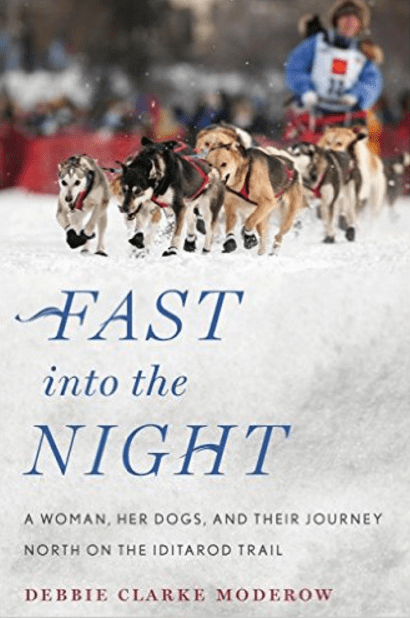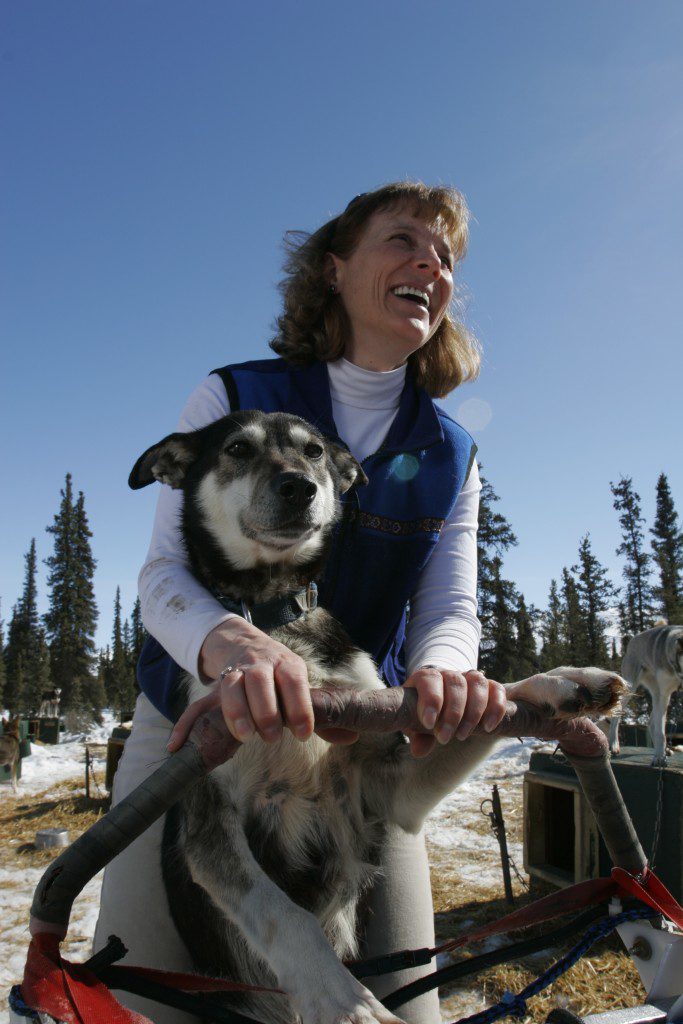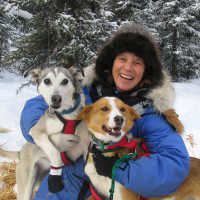Debbie Moderow was forty-seven years old when she first entered the Iditarod, Alaska’s famously grueling sled dog race. A reader opening Moderow’s new memoir, Fast Into the Night: A Woman, her Dogs, and their Journey North on the Iditarod Trail, will be prepared to admire this woman for her grit, courage and sheer stamina. What comes as a bit of a surprise is a narrator who’s humble, occasionally naïve, and refreshingly honest.
Fast Into the Night is the story of Moderow’s unlikely path to the Iditarod. Following a privileged childhood in southern Connecticut, she embarks on mountain-climbing expedition in Alaska, where she falls in love with a young attorney.
Fast forward a few years, and Moderow and her husband are happily married with two young children. But when she loses two late-term pregnancies in quick succession, Moderow descends into “a dark cocoon.” The last thing she wants is a retired husky that friends offer her family.
But it’s this husky, Salt, that ultimately pulls her back to life. Salt also introduces Moderow and her family to the world of sled dog racing.
Moderow spares us none of the thrills, surprises, or terrors of the race that takes her through a thousand miles of Alaskan wilderness. We watch her team plunge down an icy, two-hundred-foot drop. Functioning on about four hours of sleep every twenty-four hours, Moderow guides her dogs over vast expanses of ice, through whiteouts, and even blizzards. When faced with open water running across the trail, Moderow gets off the sled, takes her dogs by the collar, and pulls them across. It’s twenty degrees below zero and water is pouring over the tops of her boots. Near the end of her first race, with less than two hundred miles left to go, the team stops, sits down, and refuses to continue.
In a memoir about perseverance, unimaginable challenges, and hard-earned victories, Moderow doesn’t shy away from the painful and the inexplicable. I caught up with her by phone while she was in her home in Denali Park.
***
The Rumpus: You were living through a pretty dark time, having recently lost two pregnancies, when friends arrived on your doorstep with a retired sled dog. What happened when he joined the family?
Debbie Moderow: When Salt walked through the door, all of us fell in love with that dog. He had lived most of his life as a member of a sled team, he had lived outside, and he had already run the Iditarod several times. But he was such a gentle soul. And he pulled us all in. Slowly, we began acquiring more huskies so that the kids could compete in sled dog races.
Rumpus: How did sled dogs come to be such a passion for everyone in the family?
 Moderow: The crazy thing is that it just happened to us. I grew up playing tennis, a little soccer, field hockey, and downhill skiing. And my kids, when they were young, did t-ball and sports like that. But when we got the huskies, things just shifted. The dogs set the heart of the household. Everyone wanted to feed them breakfast. And then, before you knew it, the kids would be saving half their hamburgers from dinner so they could give them to the dogs they’d be racing the next morning.
Moderow: The crazy thing is that it just happened to us. I grew up playing tennis, a little soccer, field hockey, and downhill skiing. And my kids, when they were young, did t-ball and sports like that. But when we got the huskies, things just shifted. The dogs set the heart of the household. Everyone wanted to feed them breakfast. And then, before you knew it, the kids would be saving half their hamburgers from dinner so they could give them to the dogs they’d be racing the next morning.
It was never just about racing. We went camping and hiking with the huskies in the summer. We also had a Labrador Retriever—she didn’t make it into the book—and she encouraged our huskies to swim. So, in the summer, the kids would hop into a canoe on the lake, and eight dogs, two-by-two, would swim behind them.
Rumpus: What would people be surprised to learn about the Iditarod?
Moderow: When people think of Iditarod, they often have images of a dog team moving through the Alaskan wilderness, the dogs running in almost perfect harmony with one another, the musher standing tall on the sled. Or they may think of the finish line, where the musher is waving to everyone and then throwing his arms around the dogs.
What people may not know is the depth of the interaction between human and dog, and the mysterious connections between the dogs themselves. The interactions are subtle, but they’re ever-present.
It’s like a class of third graders. Imagine you’re at a Valentine’s Day party in the classroom. Everybody’s dressed really nicely, the children are well-behaved. One child reads a poem, maybe the class puts on a little skit. Now, imagine spending a whole week with that group of children. You’d see the class clown, you’d see the shy child. You’d get a rich, multi-dimensional picture of all the interactions in that classroom. There may be some friction here and there, either between the kids or between the teacher and the kids, but there’s a real beauty to the relationships. That’s what it’s like between a musher and a dog team.
People sometimes ask me how I remember the names of all my dogs. Well, you wouldn’t forget the names of the kids in your class—ever. You just wouldn’t.
Rumpus: I was struck by the logistical details, and the amount of planning, that go into preparing for each race. You spend an extraordinary amount of time just preparing your drop bags—the bags that you fill with provisions before the race that are dropped off at the twenty-two checkpoints along the trail. You pack some seven hundred pounds of beef, six hundred pounds of kibble, plus thirty-five bags of sliced, whole salmon, not to mention herring, lamb and beaver. How do you pack for a thousand-mile journey?
Moderow: We prepare sixty-four drop bags for Iditarod, usually three bags for every checkpoint. The first bag is always food for the dogs, the second has food for the musher, and the third has what you might call accessories. I always put in massage liniment for the dogs, extra booties, maybe an extra dog dish. I knew my dog Zeppelin would chew up harnesses all the way along the race, and he did, so I threw in extra harnesses. Every five checkpoints, maybe there’ll be a dry shirt. Maybe some clean socks.
In a sense, these drop bags become the blueprint for your race. You’ll know ahead of time that when you’re heading out of a particular checkpoint, you’re likely to encounter horrific winds, so in those drop bags you’ll pack extra coats for the dogs, extra lip balm, maybe an arctic-strength wind anorak.
Rumpus: Could you talk about some of the highs and lows of the race? It appears that you study the terrain of the course pretty thoroughly ahead of time. Can you prepare yourself for the parts of the terrain that are particularly dangerous, or is the course different every time you run the race?
Moderow: Because the weather systems in Alaska are so extreme, and the terrain is so wild, there are always highs and lows. You’d like to think, after you’ve done this sport for awhile, that you’re pretty prepared for anything. But that’s really not the case. In a race like Iditarod, the highs really always have to do with dog performance. That takes precedence over everything in a musher’s mind. When the dogs are really clicking, and when they’re just getting stronger and stronger with every mile, that trumps the Northern Lights, it trumps everything. For me, the race is all about the dogs.
The wilderness highs and lows, which often define the challenges of a race, can be very different. You can actually run into buffalo in sections along the trail, and that’s not very cool. There are places where you have to skirt around open water, and if you don’t watch out, you’re going to go in. If that happens, you have to stop right away, light a fire, and get out of your clothes before they freeze on you. You can also get lost, and then anything can happen.
You know, we train forever to do these races. We’re prepared to stop at any moment in a storm and wait it out for two or three days. And the dogs do well. If there’s a blizzard, you dig a little hole in the snow for each dog. The dogs make little cocoons, so they stay sheltered. You just wake them up to feed them. It’s not fun, but we have a plan for how to do all those things. Running Iditarod isn’t a big ego sport. It’s not an extreme sport. That’s not my game. I feel incredibly responsible for these dogs and want to be prepared for whatever might happen.
Rumpus: In your memoir, you do an extraordinary job conveying the emotional highs and lows of the race. Eight hundred miles into your first Iditarod, your dogs sit down and refuse to get up. You cajole them, plead with them, chastise them. They respond by turning their heads away and pretending they don’t hear you. You’re perplexed and humiliated, and withdraw from the race. Two years later, less than a hundred miles before the finish line, your dogs pull the same stunt. This time you respond differently, and ultimately you and team make it across the finish line. How did that first failure impact you? And what did you do differently the second time around?
 Moderow: That first race changed me. Up until that point I had been, relatively speaking, quite a perfectionist. And I had been quite successful living my life according to the maxim that if I really was diligent, and really worked hard, good things would happen. But by the end of that first race, when I didn’t get to the finish line, and felt I had lost a bond with my dogs, I felt like a real loser. I had truly failed, and I took it hard.
Moderow: That first race changed me. Up until that point I had been, relatively speaking, quite a perfectionist. And I had been quite successful living my life according to the maxim that if I really was diligent, and really worked hard, good things would happen. But by the end of that first race, when I didn’t get to the finish line, and felt I had lost a bond with my dogs, I felt like a real loser. I had truly failed, and I took it hard.
But the longer you live, the more you know that things sometimes happen that are out of your control. It doesn’t mean that you’re a failure, or that you’re helpless. You’re not. But you may need to try something different, or look at the problem from a new angle. So, during that second Iditarod, when my dogs decided to stop running, I thought, ‘What the hell? You’ve got to be kidding me!’ I didn’t doubt we had a problem, but this time I didn’t blame myself. I thought, ‘We’re going to work through this together. I don’t know how, but we will.’ In that way, I kind of left myself open for the next opportunity, the next chance.
You can’t just grind out every success in life. What I’ve learned, I think, is that doing the best you can, working through a messy struggle, is absolutely as valuable and meaningful as having a clean run—i.e., a perfect race.
In every Iditarod—and thank goodness we’ve weaned ourselves from it, because it takes over the rest of your life—you learn a lot along the way. During the race, you’re too tired to know what you’ve learned, but you’re changing as you go, and what you really want to do is go home and sleep for about a month and then do it right away again. You could do it so much better!
Rumpus: When your dogs were having some troubles during the race, I was surprised that you described yourself as “the weak link” of the team.
Moderow: The mushers are always the weak link. The huskies are born, bred, and trained to do this work. It’s our job to nurture them, make sure they’re hydrated, fed, and trained, but they’re way better adapted to long distance travel in the winter than we are. They’re metabolic machines. And during a race, they sleep more than we do.
Rumpus: In your memoir, I kept reading about unusually warm conditions. You and your husband worry that frozen food supplies for the race may spoil. There are winters where there’s not enough snow to train. And once, in the middle of a race, you learn that river ice ahead of you has broken up, forcing you and your team to navigate around open water. How does a changing climate impact you and others in the dog-sledding community?
Moderow: I have many professional musher friends who have beautiful kennels in the Anchorage and Willow area of Alaska. These days they have to truck hundreds of miles, all winter long, to train their dog teams because the rivers where they usually train aren’t freezing. It is so obvious what is happening up here. Even the most defiant people who say this is all a figment of our imagination cannot deny it. We are so into climate change already it is wildly scary.
Rumpus: What inspired you to write about your experience?
Moderow: After each race, I would write for weeks and weeks. I wrote obsessively, trying to make sense of what I had lived. The memories of the race were pretty vivid, but of course I had been so sleep-deprived when I was racing that I usually asked friends to check my facts. There are also some details that you’ll always remember. I mean, when you’ve just made it through a really scary storm, you’re never going to forget which dog was leading your team.
I knew for a long time that I wanted to write this book. I went to writer’s workshops every year—really great ones—and I thought that if I worked with a teacher, maybe took an online seminar, or even talked with some editors and agents, I’d find my way. But what I kept hearing was, “The book ought to be a family story,” or, “It’s really an adventure story,” or “Make it all about the Iditarod culture.” But I had to make it my story, in my own voice.




